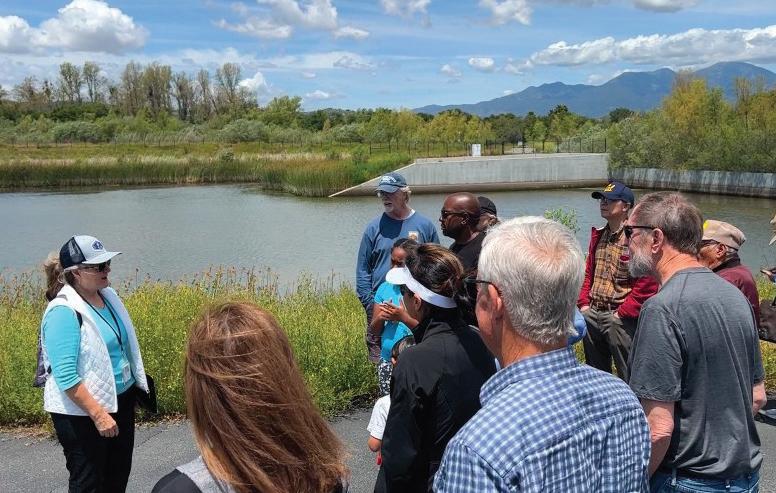
EARTH DAY TUESDAY, APRIL 22, 2025












EARTH DAY TUESDAY, APRIL 22, 2025












ew, sustainable, local, high-quality water at a reasonable cost


Reliability for natural disasters and wildfires



Drought-proof and resilient to climate change

Up to 5 million gallons per day of local drinking water supply

Potential long-term and regional benefits up to 15 million gallons per day
urrent Project Participants: Laguna Beach County Water District Eastern Municipal Water District



new, local, and drought-proof water supply that will also provide emergency water supplies should the delivery of imported water be disrupted.
The project will sustainably provide five million gallons per day of local drinking water to SCWD customers and local partners significantly reducing our reliance on imported water.


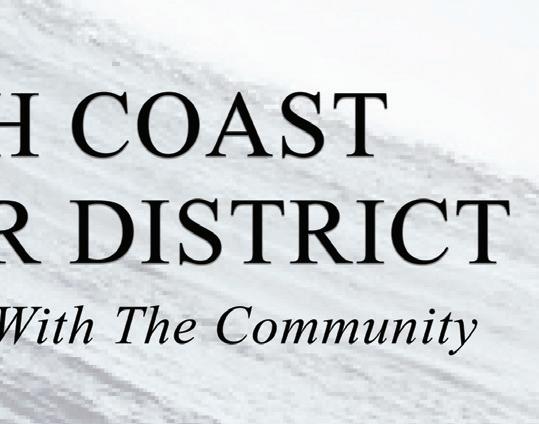





Multiple entities in the area are doing what they can to better the environment and local wildlife.
That is the emphasis for our annual Green Issue — to help our readers learn about the variety of ways they can help themselves and South Orange County while taking care of this beautiful place we call home.
In this edition, our focus is on how we can best turn food to fuel, how one young man is trying to make a noteworthy difference for world beaches, and how a couple helped take down a nuclear power plant that just didn’t belong.
The San Clemente Chamber of Commerce has continued to lead the way in educating local restau rants on how to best recycle various items within their establishments.
From teaching the basics of how to best recycle, the organization’s partnership with CR&R helped to launch a multifaceted environmental education program to pro vide local businesses and the public with resources on how to comply with the state’s newest environmental organic recycling requirements.
Then there is Ryan Hickman, a bright and determined soon-to-be 15-year-old out of San Juan Capistrano who decided, as a youngster, to start picking up trash on the beaches, which has now morphed into Project 3R.
Hickman and his team are plan ning on its most challenging clean ups to date: to execute five such events in five consecutive week ends beginning in and around Earth Day near the end of April.
We also spotlight the story of Gary and Laurie Headrick. The Headricks, activists concerned with the potential horrors asso ciated with nuclear power plants in our own backyard, created San Clemente Green for Citizens for a Sustainable Future and went to work with many other residents to get the plant in San Onofre to shut down opera tions in 2013.
That doesn’t mean the work is finished, and a recent documentary made by some determined directors chronicled the fight that continues. Many may think it is a cleaner alternative to fossil fuels or other energy means, but the documentary and what is currently happening suggests otherwise.














By Kaila Mellos
ver the past four years, a tug-of-war has played out over 13 acres of land owned by Saddleback Church in San Juan Capistrano. The land is proposed for a lithium battery storage facility, which has raised concerns among multiple cities and many of their residents about the potential environmental effects.
The battery storage facility, a 250-megawatt battery energy storage system, or BESS, would be built to collect excess energy from the power grid, store it, and discharge it during peak energy needs. More than 100 such facilities exist in Southern California, including Orange County.
The storage facility would be on 13 acres of a former ranch fronting Camino Capistrano, the railroad tracks, and the I-5 freeway. Engie is purchasing 41 acres of the 170 acres Saddleback Church owns there, and the sale is nearly complete. The remaining acres surrounding it will become preserved open space, including trails.
Compass Energy Storage, the company applying for the project, a subsidiary of Engie North America, initially proposed the project and first sent a letter with its proposal to San Juan Capistrano in 2021. Saddleback Church also initially applied and was denied by the city council for a rezoning study to align the proposed BESS with the area’s conditional uses in September 2022.
Since the first letter was sent and the application for the study was denied, the San Juan Capistrano City Council has taken action several times to temporarily prohibit the proposed commercial battery energy storage systems within city limits.
During the March 18 San Juan Capistrano City Council meeting, the governing body and staff reviewed their interim urgency ordinance to enact a moratorium they signed in April 2024 to extend it for the second time for another 10 months and 15 days for staff to continue to study the adverse effects.
Though all this action has taken place at the city level, Engie North America rescinded its application from the city in February 2024. Instead, it went straight to the California Energy Commission (CEC) for approval.
According to the commission’s records, Compass applied in April 2024.
The Compass project is one of the first to navigate the state process established by a 2022 law that expanded the energy commission’s authority to promote renewable energy projects, supporting California’s goal of achieving 100% clean energy by 2045. If the project
receives approval by the end of 2025, onsite work could commence in 2026, and it would be operational by 2027.
Engie officials have considered 17 other sites in Orange County, and, they said, no other suitable alternative exists. The site was selected because it’s near the power grid and wouldn’t require long transmission lines through neighborhoods. That proximity also means there is the ability to absorb 100% of the project’s energy.
With other facilities operating in and around California, multiple accounts of their dangers have emerged. This is troubling for the city council and various groups, particularly regarding their presence in a highly populated area.
BESS facilities that use lithium-ion batteries create particularly unique fire and explosion hazards. Lithium-ion batteries are inherently safe and stable, but certain conditions, such as impacts, punctures, mechanical damage, overcharging, overheating, and short circuits, elevate the fire risk. The proposed location is near established San Juan Capistrano residential neighborhoods and several hundred Laguna Niguel homes.
The main risks are related to fire. According to the CEC, ten major BESS safety incidents have occurred in the past five years. In January, a significant fire broke out at Vistra Energy’s BESS facility in Moss Landing, forcing over 1,500 residents to evacuate. The incident closed Highway 1, impacted local businesses, released toxic heavy metals into nearby otter habitats, and threatened prime agricultural lands and the community.
The fire risk also poses the potential for crude water runoff, which would likely flow into Trabuco Creek adjacent to the Saddleback Church property in the event of a disaster.
With the risks in mind, locals have expressed concerns regarding the proposal and established the Banning Lithium Energy Storage Systems in Neighborhoods, or B.L.E.S.S.I.N. This group has since become a 501(c)(3) non-profit with three directors, a 13-member advisory council, and 70 volunteers dedicated to preventing the BESS facility from being built on the property.
Led by Cathleen Pryor, the group’s primary focus is not to stop the green energy movement but to prevent the dangers associated with this particular use of it.
While they support renewable energy, the residents in this group express dissatisfaction with the battery site being so close to their community, raising concerns about noise, unattractive infrastructure, traffic congestion, potential pollutants, and fires reported at some other facilities.
Fire danger is the primary risk that Pryor and chief operating officer Theresa Ford highlight in their community meetings and presentations concerning the BESS facility. With this property proposed for open space, vast, brushy hillsides encircle the location, including the Colinas Bluff Trail and the adjacent neighborhoods, such as her Laguna Heights community.
“We’ve had several fires in that valley, and fire has raced up the hillsides close to the ridge of homes,” Pryor said. “Firefighters can put out brush fires, but a lithium fire you can’t just put out. If a fire broke out, it would endanger so many people. In Escondido, a container or two caught fire, and they evacuated 13 miles from that thing.”
With the help of 19,000 flyers distributed in Laguna Niguel, San Juan Capistrano, and Dana Point, the group has gained community support and has joined many other groups in writing letters of concern to the CEC.
Groups like The Boys and Girls Club of Capistrano Valley, the Capistrano Unified School District, and the Sacred Places Institute for Indigenous Peoples have all written letters of concern.
Representatives from Amtrak and the Los AngelesSan Diego-San Luis Obispo Rail Corridor Agency have also raised concerns with the state commission about large vehicles near the rail crossing obstructing the only road into the area.
The Orange County Board of Supervisors has also taken further action. It approved a moratorium on Feb. 5 on new battery energy storage system facilities in response to a recent fire in Monterey County that burned for two days. It is the largest battery accident on record.
“As the most recent fires in Monterey in 2025 and San Diego in 2024 demonstrate, fires involving BESS facilities carry with them specific challenges for firefighters as well as concerns about toxic fumes being released by fires,” Orange County Supervisor Katrina Foley said in a letter to the Board of Supervisors.
In a more significant act to end the use of these BESS facilities after the Moss Landing fires, AB 303 was introduced. California State Assemblymember Dawn Addis brought this legislation from the 30th District representing Monterey, San Luis Obispo, and Santa Cruz.
AB 303, or the Battery Energy Safety and Accountability Act, promotes climate justice by amplifying the voices of local Californians and establishing sensible siting requirements for potentially hazardous battery energy storage system (BESS) facilities. It acknowledges that utility-scale battery energy storage has been crucial in achieving California’s energy goals and addressing the climate crisis. Nevertheless, it ensures that we do not repeat past mistakes that allowed the industry to sidestep local communities in locating energy projects in sensitive areas where they harmed human and environmental health. It also firmly opposes federal attacks on environmental regulations.
This bill does two things: restores community input to the BESS permitting process and establishes reasonable setbacks for BESS facilities from areas such as schools, homes, hospitals, prime agricultural land, and environmentally sensitive habitats. Returning power to communities is vital for maintaining environmental safety. In conjunction with numerous other community groups that continue to oppose the facility, B.L.E.S.S.I.N. will host a series of community meetings and serve as a resource for submitting comments and letters to the CEC.
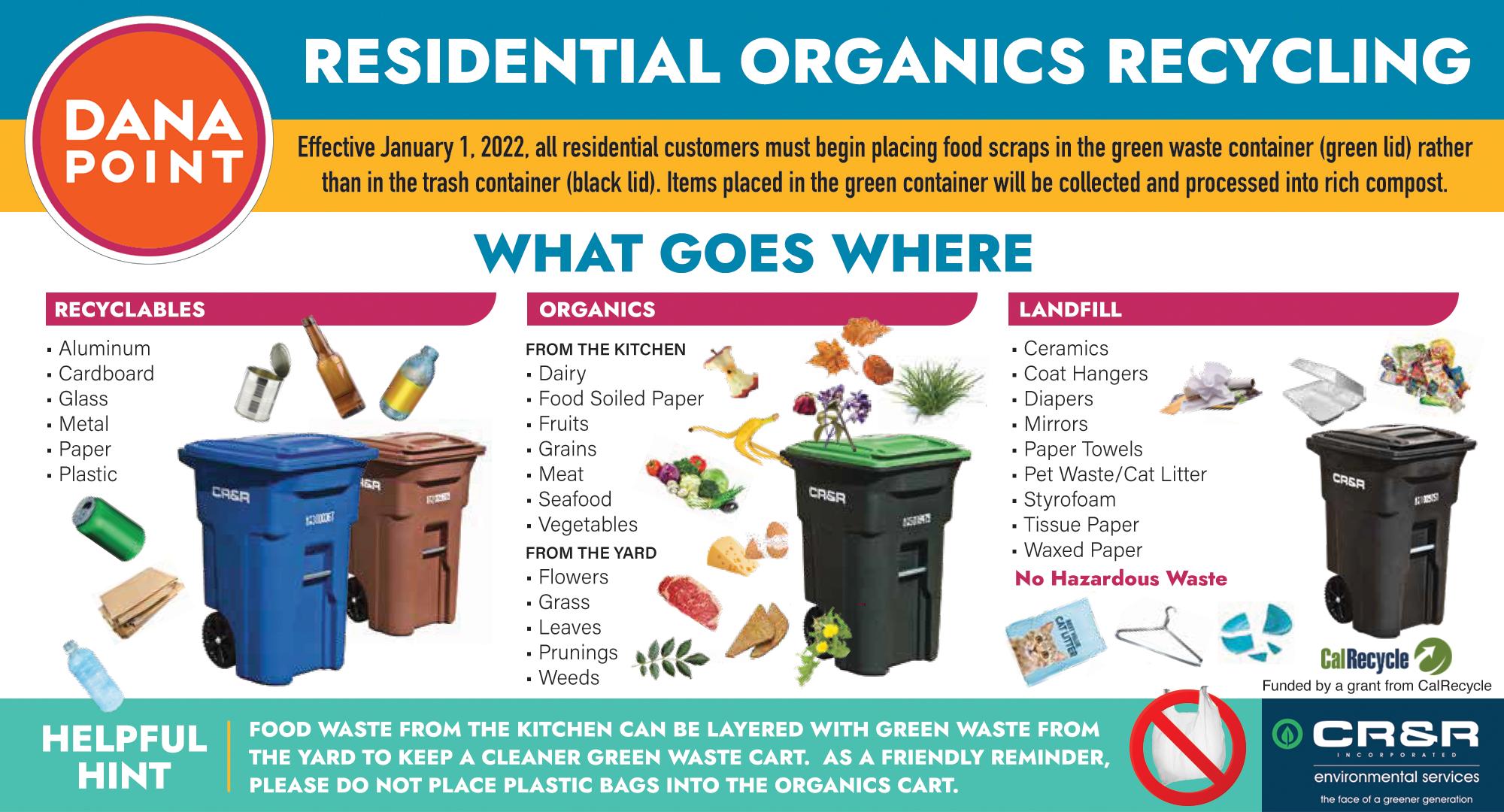
By Angélica Escobar
s powerful winter storms and decades of sediment loss continue eroding San Clemente’s coastline, a new generation of community advocates and environmental organizations is reimagining how to restore and protect local beaches — without sacrificing access, ecology, or identity.
At San Onofre State Beach, the Surfrider Foundation has started to explore naturebased solutions to preserve one of California’s most iconic surf spots. Among those involved in the project is Alex Ferron Mignogna, the nonprofit’s Living Shorelines Coordinator, who emphasizes that although it’s still early days, the work is rooted in community engagement.
“San Onofre is a highly used, well-loved beach,” Mignogna said. “We’ve seen access threatened by erosion in the past, and we’re reaching a point where a more long-term, comprehensive plan is needed.”
A seawall constructed by California State Parks in 2017 helped prevent immediate damage but caused accelerated erosion in surrounding areas. Now, Surfrider is collaborating with stakeholders, engineers, and beachgoers to develop future shoreline stabilization measures that prioritize resilience and community use.
Thanks to a recent grant from the California State Coastal Conservancy, the organization is entering a new phase: gathering design ideas that reflect the beach’s natural processes and cultural significance. The initial concepts are inspired by success stories like Ventura’s Surfers Point, where hard infrastructure was moved back and replaced with native dunes and setback parking — allowing the shoreline to breathe while maintaining access.
“We’re trying to understand what the beach does naturally, what it’s struggling with, and how we can design with that instead of against it,” Mignogna said. “This isn’t about putting a fix in place and walking away. It’s about building something sustainable for the long term.”
The Surfrider Foundation’s initial outreach included stakeholder workshops and onthe-sand conversations with visitors, where people were asked to mark up maps, share concerns, and describe what they value most about the beach. That input will guide the design process moving forward as engineers begin to study the shoreline and explore possible solutions rooted in nature-based
design.
The challenges confronting San Onofre resonate throughout San Clemente’s coastline. For Suzie Whitelaw, an environmental geologist and co-founder of Save Our Beaches SC, this issue has been developing for decades.
“A lot of people think the erosion we’re seeing now is because of sea level rise,” Whitelaw said. “But sea level in California has only risen about 6 inches in the last 100 years. The real damage started in 1970, when the Dana Point Harbor was built.”
The harbor construction initially added 7 million cubic yards of sand to local beaches, resulting in unusually wide shorelines. In 1972, Whitelaw recalls a “huge” beach in front of Mariposa. However, since then, changes in wave direction and sand supply from San Juan Creek have reversed the trend, sending sand offshore rather than replenishing it locally.
“Now, every winter storm takes more sand away,” she explained. “Some of it comes back in the summer — but not all. When we have strong El Niño years, that sand goes too far offshore, and we lose it for good.”
Whitelaw and a group of neighbors founded Save Our Beaches SC as a grassroots advocacy group after she noticed dramatic beach loss within just a few years of moving near Cyprus Shore.
“As a geologist, I could see where this was headed,” she said. “We started speaking to the City Council, and when no one listened, we formed a volunteer group to raise awareness and push for action.”
For Whitelaw, the beach is more than just a place for fun in the sun.
“It protects our homes, supports biodiversity, and brings people together,” she said. “The beach is an equalizer. It’s where people of all backgrounds gather. That’s worth protecting.”
She also cautioned against alternatives like cobble beaches, which she described as unfriendly to recreation and unsuitable for the native sandy habitat.
“There’s a whole world of life under that sand. Just because you can’t see it doesn’t mean it’s not there.”
Surfrider and Save Our Beaches SC agree that community input and ecological foresight should be at the forefront of shaping San Clemente’s coastline — whether through native dune systems, sand retention, or long-term infrastructure planning.
“Sand is expensive and temporary,” Mignogna said. “If we don’t start designing with nature in mind, we’re just going to keep losing ground — literally.”
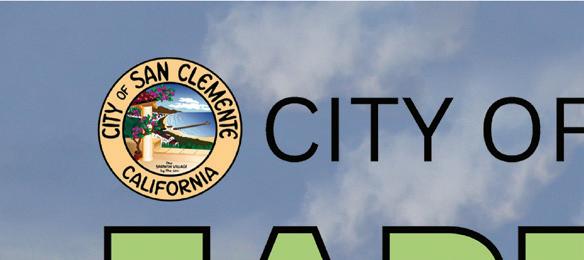
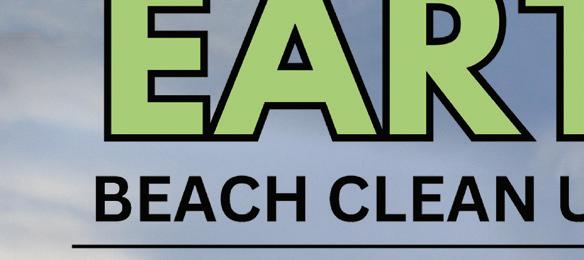


APRIL 26, 2025, 9AM - 1PM
PIER & PARQUE DEL MAR
622 AVE. DEL MAR, SAN CLEMENTE, CA




EDUCATIONAL FAIR




CITY VEHICLE/EQUIPMENT DISPLAYS FUN AND GAMES FOR THE FAMILY SPECIAL APPEARANCE BY RICKY RAINDROP












Pre-register for the Beach Cleanup for a FREE BURRITO from Fisherman’s!


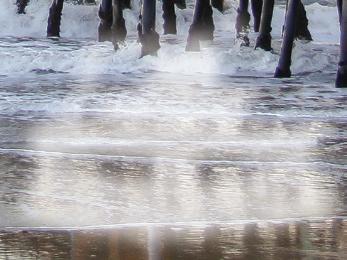

•Maintain your sprinklers to control runo .
•Clean up after your dog on walks.
•Be mindful of wasteful single-use item consumption.
•Keep carwash water out of streets.
•Don’t allow home project materials to be washed into the storm drain.


